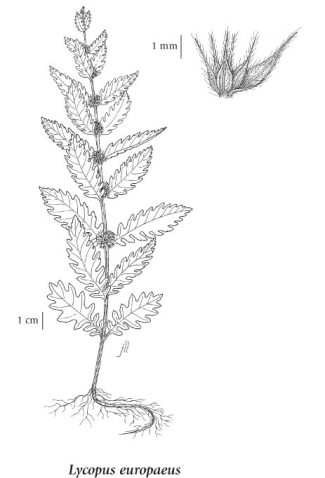Lycopus europaeus L.
European horehound (gypsywort)
Lamiaceae (Mint family)
Introduction to Vascular Plants
European horehound (gypsywort)
Lamiaceae (Mint family)
Introduction to Vascular Plants
Species Information
General:
Perennial herb from a creeping rhizome; stems erect, unbranched or with ascending branches, 30-100 cm tall, 4-angled, somewhat hairy.
Leaves:
Opposite, egg-shaped to lanceolate, to 10 cm long, tips pointed, pinnately-lobed, the lobes triangular and pointed, the lower often lobed to the midrib; short-stalked.
Flowers:
Inflorescence of many-flowered, distant clusters, in axils of bracts similar to leaves; corollas tubular, 4-lobed, white with a few small purple dots on lower lip, about 3 mm long and wide; calyces egg-shaped to bell-shaped, the teeth 5, lanceolate, hairy, spine-tipped.
Fruits:
Nutlets, 4 clustered together, 4-angled, flat at the top.
Illustration

If more than one illustration is available for a species (e.g., separate illustrations were provided for two subspecies) then links to the separate images will be provided below. Note that individual subspecies or varietal illustrations are not always available.
Illustration Source: The Illustrated Flora of British Columbia
Habitat and Range
Wet lakeshores, pond margins and riverbanks in the lowland zone; rare in SE BC (Salmo), common in SW BC, known only from the lower Fraser Valley; introduced from Europe.Status Information
Synonyms
Synonyms and Alternate Names:
Lycopus europaeus subsp. mollis (Kern.) Rothm. ex Skalickÿ
Lycopus europaeus var. mollis (Kern.) Briq.